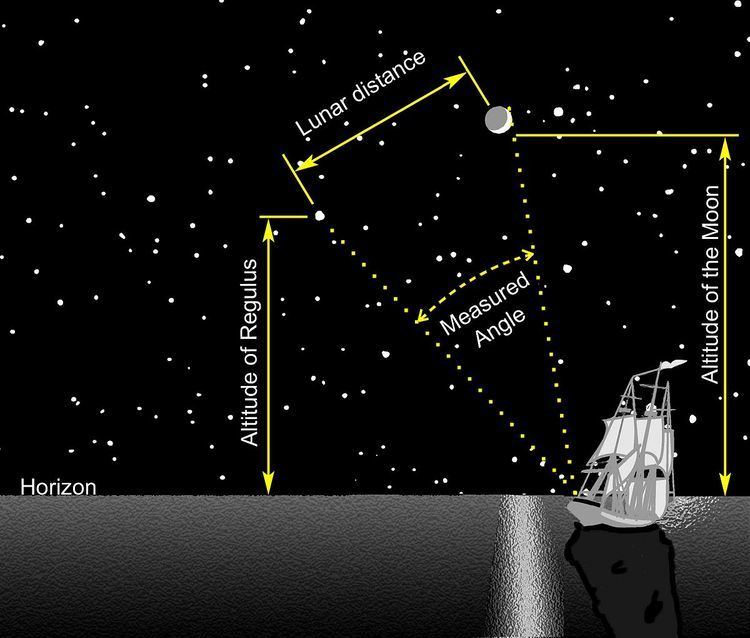 | ||
In celestial navigation, lunar distance is the angle between the Moon and another celestial body. The lunar distances method uses this angle, also called a lunar, and a nautical almanac to calculate Greenwich time. By comparing that calculated time to the measured local time, the navigator can determine longitude. The method was published in 1763 and used until about 1850 when it was superseded by the marine chronometer. It saw limited usage all the way up to the beginning of the 20th century on smaller vessels that could not afford a chronometer or had to rely on this technique for correction of the chronometer. A similar method uses the positions of the Galilean moons of Jupiter.
Contents
Purpose
In celestial navigation, knowledge of the time at Greenwich and the measured positions of one or more celestial objects allows the navigator to calculate latitude and longitude. Reliable marine chronometers were unavailable until the late 18th century and not affordable until the 19th century. After the method was first published in 1763 by British astronomer royal Nevil Maskelyne, for about a hundred years (until about 1850) mariners lacking a chronometer used the method of lunar distances to determine Greenwich time as a key step in determining longitude. Conversely, a mariner with a chronometer could check its accuracy using a lunar determination of Greenwich time. The method saw usage all the way up to the beginning of the 20th century on smaller vessels that could not afford a chronometer or had to rely on the this technique for correction of the chronometer.
Summary
The method relies on the relatively quick movement of the moon across the background sky, completing a circuit of 360 degrees in 27.3 days. In an hour then, it will move about half a degree, roughly its own diameter, with respect to the background stars and the Sun. Using a sextant, the navigator precisely measures the angle between the moon and another body. That could be the Sun or one of a selected group of bright stars lying close to the Moon's path, near the ecliptic; Regulus was particularly commonly used. At that moment, anyone on the surface of the earth who can see the same two bodies will observe the same angle (after correcting for parallax error). The navigator then consults a prepared table of lunar distances and the times at which they will occur. By comparing the corrected lunar distance with the tabulated values, the navigator finds the Greenwich time for that observation. Knowing Greenwich time and local time, the navigator can work out longitude. Local time can be determined from a sextant observation of the altitude of the Sun or a star. Then the longitude (relative to Greenwich) is readily calculated from the difference between local time and Greenwich Time, at 15 degrees per hour.
In practice
Having measured the lunar distance and the heights of the two bodies, the navigator can find Greenwich time in three steps.
Having found the (absolute) Greenwich time, the navigator either compares it with the observed local apparent time (a separate observation) to find longitude or compares it with the Greenwich time on a chronometer if one is available.
Errors
In literature
Captain Joshua Slocum, in making the first solo circumnavigation in 1895–1898, somewhat anachronistically used the lunar method along with dead reckoning in his navigation. He comments in Sailing Alone Around the World on a sight taken in the South Pacific. After correcting an error he found in his log tables, the result was surprisingly accurate:
I found from the result of three observations, after long wrestling with lunar tables, that her longitude agreed within five miles of that by dead-reckoning. This was wonderful; both, however, might be in error, but somehow I felt confident that both were nearly true, and that in a few hours more I should see land; and so it happened, for then I made out the island of Nukahiva, the southernmost of the Marquesas group, clear-cut and lofty. The verified longitude when abreast was somewhere between the two reckonings; this was extraordinary. All navigators will tell you that from one day to another a ship may lose or gain more than five miles in her sailing-account, and again, in the matter of lunars, even expert lunarians are considered as doing clever work when they average within eight miles of the truth...
The result of these observations naturally tickled my vanity, for I knew it was something to stand on a great ship’s deck and with two assistants take lunar observations approximately near the truth. As one of the poorest of American sailors, I was proud of the little achievement alone on the sloop, even by chance though it may have been...
The work of the lunarian, though seldom practised in these days of chronometers, is beautifully edifying, and there is nothing in the realm of navigation that lifts one’s heart up more in adoration.
